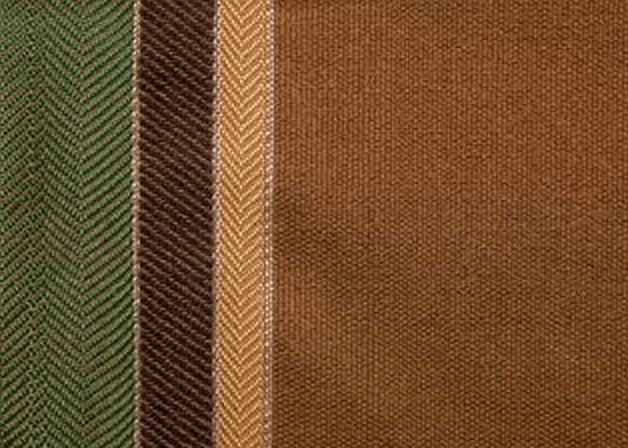Our Blog
Choosing The Right Upholstered Fabric
August 10, 2015 02:43:48pm
Finding the best fabric for your upholstery project is a big task! Before the upholstery project is even scheduled, you’ll probably find yourself sifting through an endless array of fabrics, including natural, synthetic, and blended fabrics in any color and pattern imaginable. If you’ve ever felt overwhelmed by your options, you’re certainly not alone. Breathe a sigh of relief, though, because we’ve got tips for finding the fabric that is perfect for your project.
Tip 1: Consider the furniture.
Before delving into patterns, colors, and textures, consider how the furniture will be used. Is it a sofa that will receive daily use? If so, skip the silk and satin and focus on sturdy, textured blends. Is it an antique chair that will be used for decoration in a seldom-used guest room? In that case, a nice toile in an era-specific pattern might look best.
Tip 2: Understand the fabric.
Great upholstery companies employ craftsmen who are well versed in working in all types of fabric, especially cotton, leather, wool, and blends. Understanding the features of each fabric can help you decide on the right one for your own furniture.
Cotton – Cotton has many benefits. It holds its dye well, so it’s a great fabric for deep colors or patterns. It’s a comfortable, casual fabric, and it’s easy to clean, so we can freely use it on furniture that gets regular use. It’s also extremely durable, and known for being one of the strongest natural fibers available. Cotton can fade and yellow in direct sunlight, though, so plan on keeping it away from windows or areas that get direct sunlight. It also can be susceptible to mildew in damp environments, so plan to keep it away from open windows or doors leading to the outside of the home.
Leather – Leather has an unmistakable look and gives furniture the air of sophistication and luxury. Leather is also easy to clean and ages well. It’s durable, but still susceptible to tears and scrapes, so many homeowners choose to keep leather furniture away from high traffic areas or rooms where pets and children play. Depending on what your leather furniture is used for, you may need to maintain it with special leather conditioner to keep natural oils and body oils at bay.
Poly-Blends – Blends, namely polyester blends, are a favorite fabric style for many homeowners and designers because of versatility and durability. Poly-blends can consist of acrylic, nylon, rayon, or other synthetic fibers, and can be blended with natural fibers to enhance their performance in certain ways. Poly-blends can also be made to look like different fabrics, including silk and wool, allowing you to create the look of such fabrics, but at a lower cost. Perhaps best of all, these fabrics are resistant to fading and stains, so they are a great choice for homes with pets and small children.
Wool – Wool is a versatile fabric. It is resistant to pilling, wrinkling, and fading, and repels dirt well. Wool can be tough to clean, so it is often blended with synthetic fiber to make cleanup easier.
Tip 3: Understand the labels and fabric terminology.
Take a look at the cleaning label for your fabric. The labels on your clothing are likely spelled out, but the labels on fabric often use abbreviations, such as the following:
W: Use only water-based cleaners
S: Use only water-based dry cleaning solvents
WS: Use either water-based cleaners or water-based dry cleaning solvents
X: Only vacuum or lightly brush (avoid any and all cleaners and solvents)
If an employee at the fabric store is helping you look for a fabric, he or she might use some terminology to describe the fabric, including the following terms:
Fabric grade: “Fabric grade” is a term that relates to pricing. Depending on the type of material, the weave, and the design, a fabric may have a grade of A or 1, which is low in cost, or H or 7 (or above), which is high in cost, or anywhere in between. Note that the fabric grade is only a pricing convention, and has nothing to do with the quality of the fabric.
Rub test: A “rub test” is a term relating to the test of a fabric’s strength. In this test, a machine performs back and forth rubbing motions on the material and counts how many it can withstand before tearing. (Example: 15,000 double rubs is considered the average. Anything below is weaker, and anything above is stronger.)
If you are still on the fence about which fabric to choose for your upholstering project, the craftsmen at your furniture refinishing service will be able to work with you to select the perfect material. The best upholstery shops employ technicians who are trained to understand the details of all kinds of fabric and know how to carefully handle and adeptly work with nearly any material.
The Best Northeast FL Upholstery Service
Jax Furniture Refinishing & Upholstering is the best upholstery shop Jacksonville FL has to offer – just ask our clients in downtown Jacksonville, Ortega, St. Augustine, Fleming Island, and beyond. Fine furniture is our specialty, and our expertise in upholstering fabric furniture is unmatched. Our master craftsmen and technicians are highly skilled artisans, ready to turn your faded, yellowed, or torn fabric furniture into a stunning work of art.









